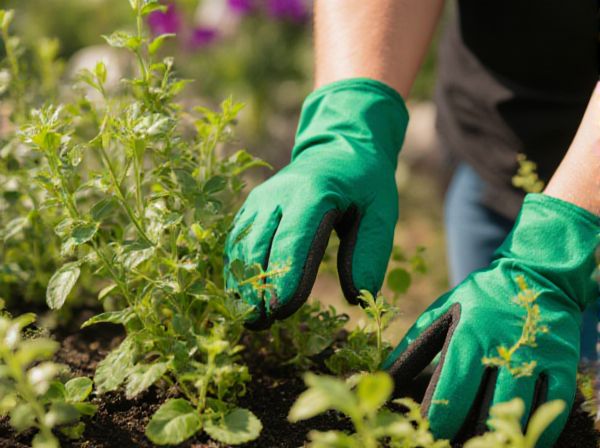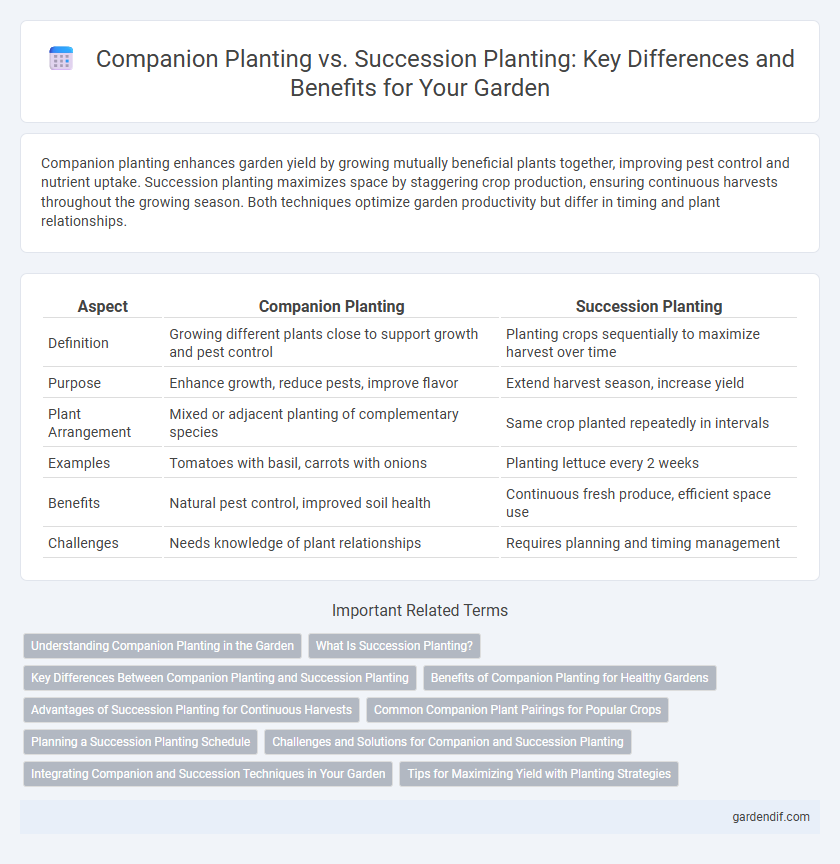
Companion Planting vs Succession Planting Illustration
Companion planting enhances garden yield by growing mutually beneficial plants together, improving pest control and nutrient uptake. Succession planting maximizes space by staggering crop production, ensuring continuous harvests throughout the growing season. Both techniques optimize garden productivity but differ in timing and plant relationships.
Table of Comparison
| Aspect | Companion Planting | Succession Planting |
|---|---|---|
| Definition | Growing different plants close to support growth and pest control | Planting crops sequentially to maximize harvest over time |
| Purpose | Enhance growth, reduce pests, improve flavor | Extend harvest season, increase yield |
| Plant Arrangement | Mixed or adjacent planting of complementary species | Same crop planted repeatedly in intervals |
| Examples | Tomatoes with basil, carrots with onions | Planting lettuce every 2 weeks |
| Benefits | Natural pest control, improved soil health | Continuous fresh produce, efficient space use |
| Challenges | Needs knowledge of plant relationships | Requires planning and timing management |
Understanding Companion Planting in the Garden
Companion planting involves growing specific plants together to enhance growth, improve pest control, and increase yields through natural synergy. By selecting compatible plant pairs, such as tomatoes with basil or carrots with onions, gardeners can optimize space and resource use while reducing the need for chemical interventions. Understanding the benefits of companion planting helps create a balanced garden ecosystem, promoting healthier plants and sustainable gardening practices.
What Is Succession Planting?
Succession planting is an agricultural technique where crops are planted in intervals to ensure continuous harvest throughout the growing season. This method maximizes garden space and productivity by staggering planting times for different crops or varieties. Unlike companion planting, which emphasizes plant compatibility, succession planting focuses on timing to maintain a steady supply of fresh produce.
Key Differences Between Companion Planting and Succession Planting
Companion planting involves growing complementary plant species together to enhance growth, pest control, and pollination, while succession planting focuses on timing and spacing crops sequentially to maximize yield over the growing season. Companion planting relies on plant relationships, such as legumes fixing nitrogen for nearby crops, whereas succession planting emphasizes continuous harvest by staggering planting dates or replacing harvested crops. Understanding these key distinctions optimizes garden productivity and pest management strategies.
Benefits of Companion Planting for Healthy Gardens
Companion planting enhances garden health by naturally deterring pests, improving pollination, and promoting nutrient-rich soil through plant diversity. Beneficial plant pairings like basil with tomatoes increase yield and flavor while reducing the need for chemical interventions. This method supports sustainable gardening practices, fostering resilient ecosystems and robust plant growth.
Advantages of Succession Planting for Continuous Harvests
Succession planting maximizes garden productivity by staggering planting dates, ensuring continuous harvests throughout the growing season. This method reduces crop downtime and optimizes space, leading to a steady supply of fresh vegetables like lettuce, beans, and carrots. Unlike companion planting, which emphasizes mutual benefits between different species, succession planting focuses on timing to maintain consistent yield and soil health.
Common Companion Plant Pairings for Popular Crops
Common companion plant pairings for popular crops include tomatoes with basil and marigolds, which enhance growth and repel pests. Beans often thrive alongside corn and squash in the traditional Three Sisters method, improving soil nitrogen levels and providing mutual support. Lettuce benefits from being planted near carrots and radishes, as these combinations optimize space and reduce pest interference.
Planning a Succession Planting Schedule
Planning a succession planting schedule involves carefully timing the sowing and harvesting of crops to maximize garden yield throughout the growing season. Companion planting focuses on growing different species together for mutual benefits like pest control and nutrient sharing, whereas succession planting emphasizes staggered planting to ensure continuous harvest. Effective succession planting requires evaluating crop maturity rates, climate conditions, and soil health to optimize planting intervals and extend productivity.
Challenges and Solutions for Companion and Succession Planting
Companion planting faces challenges such as competition for nutrients and space, which can be mitigated by selecting compatible plant pairs and optimizing planting distances. Succession planting requires precise timing to avoid overcrowding and ensure continuous harvests, addressed by careful scheduling and soil management. Both methods benefit from monitoring plant health and soil conditions to maximize growth and yield.
Integrating Companion and Succession Techniques in Your Garden
Integrating companion planting with succession planting maximizes garden productivity by enhancing plant health and ensuring continuous harvests. Companion planting promotes natural pest control and nutrient sharing between compatible species, while succession planting schedules crops in overlapping intervals to maintain soil fertility and space efficiency. Combining these techniques creates a dynamic garden ecosystem that supports sustainable growth and year-round yield.
Tips for Maximizing Yield with Planting Strategies
Companion planting improves yield by pairing compatible plants that enhance growth, deter pests, and improve soil nutrients, such as tomatoes with basil or beans with corn. Succession planting maximizes harvest by staggering planting times, allowing continuous production across the growing season and optimizing space use. Combining both techniques increases garden productivity by promoting healthy plant relationships and ensuring a steady supply of crops.
Companion Planting vs Succession Planting Infographic

 gardendif.com
gardendif.com